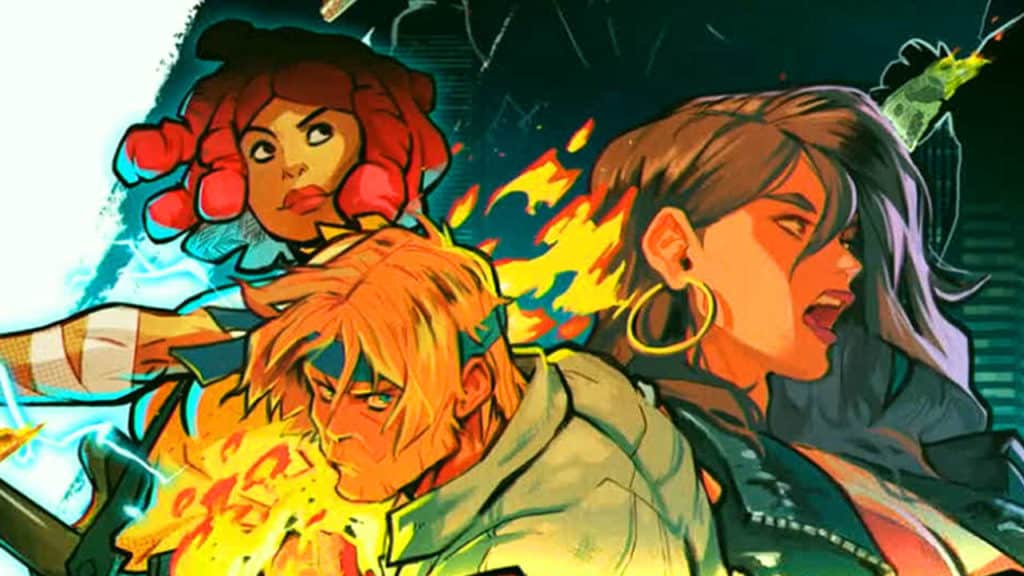Video Gamer is reader-supported. When you buy through links on our site, we may earn an affiliate commission. Prices subject to change. Learn more
Having played through Streets of Rage 4, I can’t help but wonder: where is all the rage? I only see joy. The game is too glossy to deal in decay. With The Warriors, Rockstar gave us a night-bruised New York city—a seamy, spray-can vision of nastiness, lit with achy throbs of neon and sodium. Streets of Rage 4 presents us with the same spectacle (albeit not the same city) as it might be seen on Saturday morning, spooned down with pools of sugary milk. As one of five characters—most of them ex-cops, all of them cartoons—you clatter through the alleyways and slug your way into police precincts heaving with heavy-bellied officers, ready to rumble. The graffiti is as bright as blood—of which not a drop is spilled—and the brawlers brawl not for any papery plot but because they simply must. The streets are a stage.
The series was founded on these dream-fuelled principles back in 1991, on the Sega Mega Drive. Streets of Rage was a side-scrolling beat ’em up, in the mould of Double Dragon and Final Fight, in which you punched rubbish bins to reveal cooked, health-charging chickens and called in rocket launcher support from a squad car. Such low regard for reality only signals a high regard for the ripe oddities of the medium, and anyone acquainted with the Yakuza series (which is essentially what Streets of Rage became), will smile at the sparks that fly as video game rules rage against the machine of recognisable life.

It’s been 26 years since Streets of Rage 3, and for publisher and co-developer Dotemu the question is: how do you make a game whose streets appeal to fresh players, while pleasing those who would despair at the most pixel-sized of inauthenticities? One answer is: get Lizardcube to do your artwork. The small French studio made Wonderboy: The Dragon’s Trap, in 2017, a remake of a Master System game from 1989, and its work is defined by a devilish blend of blasphemy and devout faith: the willingness to scrap the past completely and render instead the effect it had on us, the way it made us feel—to give an artist’s impression of the impression, so to speak. The result? The pixels are gone, and the chickens are back. The visuals are hand drawn, and they move like fast-flowing paint. The backgrounds are washed and dotted, with discerning care, like the panels of a comic book, and the characters pop in high-fructose hues—cherry reds and sour-lemon yellows. It’s possible that PEGI might have to amend its guidelines to include a “non-edible” warning.
Not that that would stop veteran fans from eating this up. There are carefully strewn easter eggs throughout—take a taser to one of the arcade cabinets, for instance, and you are jolted back in time to a blurry bonus level. You can unlock old-fashioned character models, which have a lovely Minecraft crustiness. And the soundtrack is supplied by original composer Yuzo Koshiro, along with the lively touch of Olivier Deriviere. Imagine getting into a fight in a French nightclub, which also happens to be an arcade, in 2002, and you’ll have some idea. But what thrills await those for whom the name comes unburdened with the baggage of reverence?
/https://oimg.videogamer.com/meta/6d45/33da38b3-2dd3-4468-b971-58a48c31d9e7_SoR4_3.jpg)

Well, a fighting system that feels somehow tightly trimmed, and wondrously scornful of logic. Offence isn’t the best defence; it’s the only defence. There is no block button; instead you are given a defensive attack—with returning star Axel Stone, for instance, a fiery 360-degree sweep—and you are told that throwing your opponents gives you a brief window of invincibility. You can also moonwalk into the foreground or background, slipping the lines of your enemies’ attack. Should you wish to build up a combo—and the upward tick of numbers, at the top of screen, is all it has ever taken for that desire to be teased out—then you can do so with your special attacks. These chop off provisional chunks of your health bar, which you have a chance to regain by landing regular attacks. The combat has been provided courtesy of Guard Crush Games, as well as designers at Dotemu, who understand that simplicity, while open to charges of repetitiveness, can also set you free. Streets of Rage 4 isn’t long—it can be thumped through in a morning—but its elements allow for creative play, and thus the hours accrue.
And you wouldn’t want it any other way. The game, like its forebears, is best squeezed into a stolen afternoon, taken out tactically when one’s spirits begin to droop. The people that have been waiting for this, in one way or another, for over two decades, may well feel some missing part of their soul slotting back into place, like a silicone cartridge. I can’t vouch for such powers, but I will say that when the credits rolled, I felt better, gunning for action, as if life were a thing to rage through with a smile on your face. How often does that happen?
Developer: Dotemu, Lizardcube, Guard Crush Games
Publisher: Dotemu
Available on: PlayStation 4 [reviewed on], Xbox One, Nintendo Switch, and PC
Release date: April 30, 2020
To check what a review score means from us, click here.

